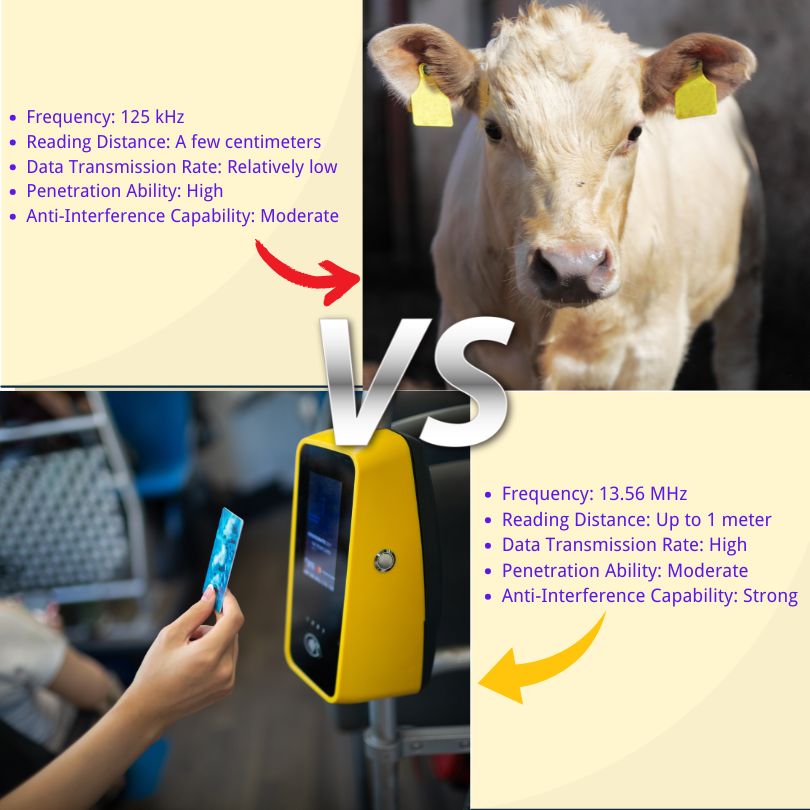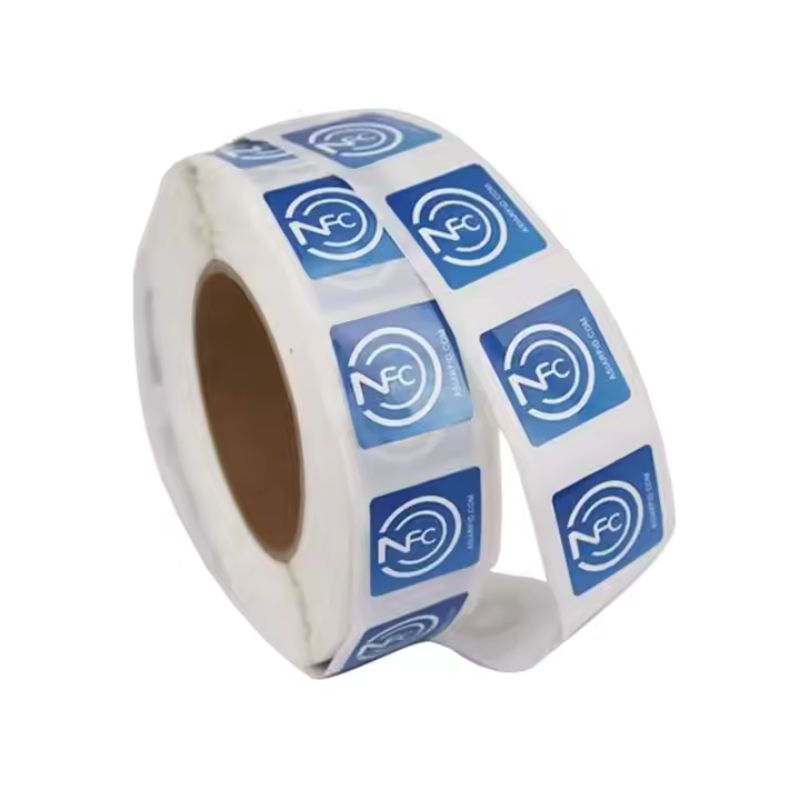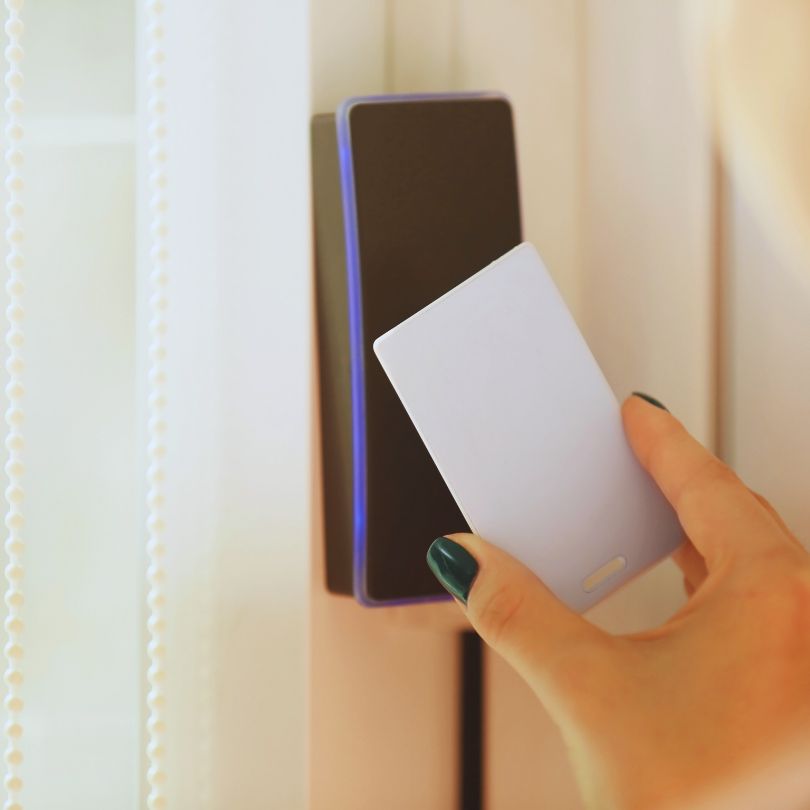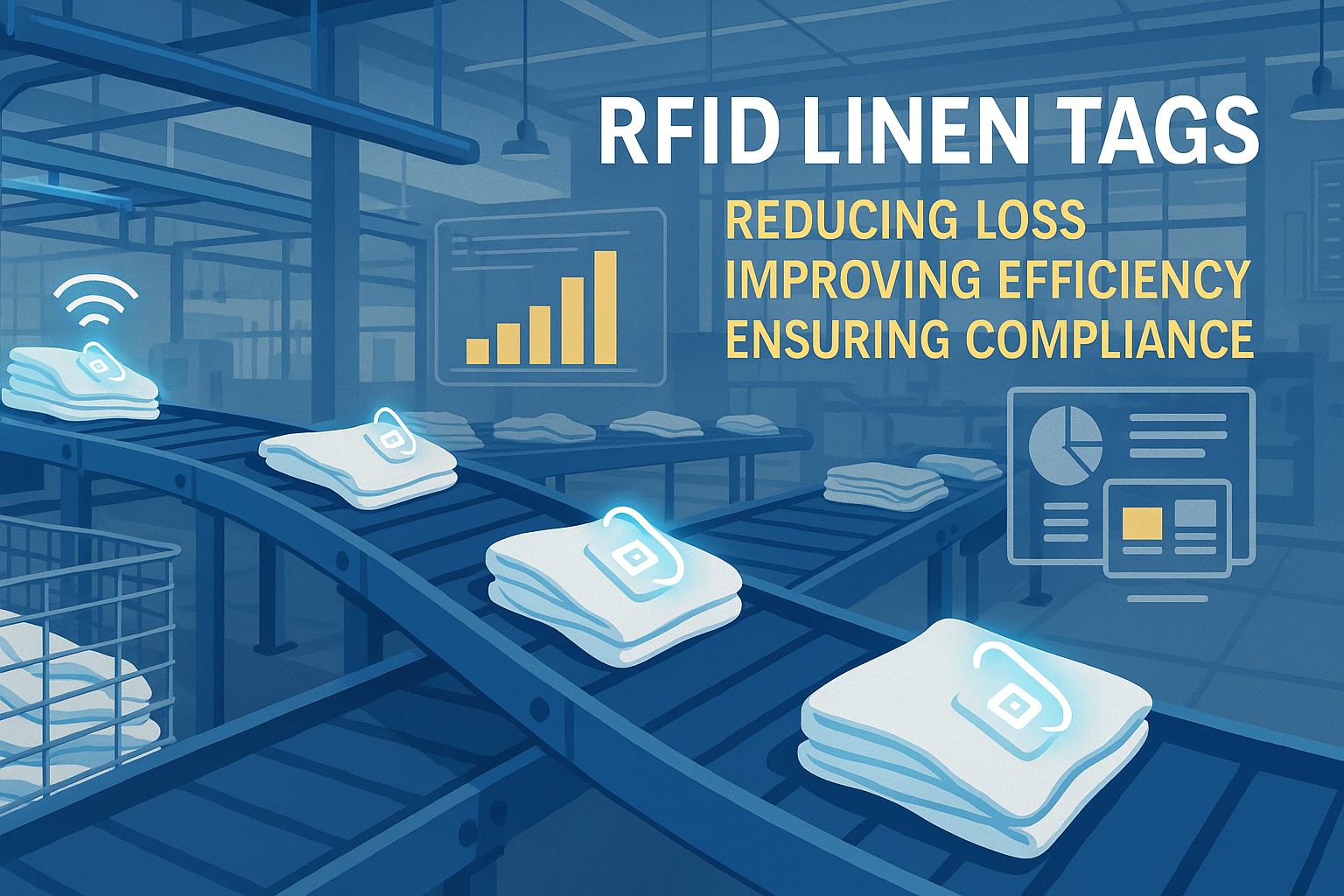
13.56MHz와 125kHz RFID 태그의 차이점 이해
목차
13.56MHz와 125kHz RFID 태그의 차이점 이해

RFID 주파수의 진정한 의미 (저주파 대 고주파)
RFID 시스템은 무선 주파수를 이용해 통신합니다. 태그 그리고 리더. 사용 빈도는 그들이 읽을 수 있는 거리, 데이터 전송 속도, 금속이나 물 주변에서의 동작 방식, 저장 가능한 데이터 유형에 영향을 미칩니다.
핵심 아이디어는 다음과 같습니다:
저주파(LF) = 125kHz RFID 태그
- 단거리
- 더 느린 데이터 전송 속도
- 금속 또는 액체 근처에서 우수한 성능
- 간단하고, 견고하며, 저렴하다
고주파(HF) = 13.56MHz RFID 태그 - 더 긴 범위
- 더 빠른 데이터 전송률
- 더 발전된 보안
- NFC 및 스마트폰과 호환됩니다
13.56 MHz 대 125 kHz
| 특징 | 13.56MHz RFID 태그 | 125kHz RFID 태그 |
|---|---|---|
| 빈도 | 13.56MHz(고주파) | 125kHz(LF) |
| 읽기 범위 | 최대 1미터 | 2-10cm |
| 데이터 전송 속도 | 높은 | 낮은 |
| 금속 근처에서의 성능 | 보통의 | 강한 |
| 보안 | 암호화 및 상호 인증을 지원합니다. | 기본, 일반적으로 암호화 없음 |
| NFC / 스마트폰 지원 | 예 | 아니요 |
| 비용 | 더 높은 | 낮추다 |

보안: 하나의 주파수가 더 안전한가?
125kHz RFID 태그 기존 시스템에서 흔히 사용되며 일반적으로 암호화되지 않은 고정된 고유 ID를 사용합니다. 이로 인해 시중에서 구입 가능한 장치로 쉽게 복제할 수 있습니다. 위험도가 낮은 시스템에는 적합하지만 현대적인 보안 기준을 충족하지 못합니다.
13.56 MHz RFID 태그, 특히 MIFARE 또는 DESFire 카드는 다음을 지원합니다:
- 암호화
- 상호 인증
- 안전한 메모리 저장
- 단일 카드에 여러 애플리케이션
결론적으로: - 보안 수준이 낮은 용도(예: 사물함 열쇠, 출퇴근 기록기)에는 125kHz RFID 태그를 사용하십시오.
- 출입 통제, 결제 또는 개인 데이터를 저장하는 모든 시스템에는 13.56 MHz를 선택하십시오.
NFC 및 스마트폰 호환성
프로젝트에 휴대폰이 포함된다면, 125kHz RFID 태그는 작동하지 않습니다.
오직 13.56MHz RFID 태그 NFC(근거리 무선 통신)를 지원합니다. 이는 모바일 결제, 체크인, 탭하여 페어링 기능에 사용되는 기술입니다.
대부분의 스마트폰은 13.56MHz를 사용하여 NFC 태그를 읽고 쓸 수 있으므로, 이 주파수는 다음과 같은 용도에 이상적입니다:
- 디지털 티켓
- 이벤트 체크인
- 스마트 포스터
- 로열티 카드
- 비접촉식 모바일 ID
스마트폰 지원이 중요하다면, 13.56MHz가 유일한 선택입니다.
산업별 실제 적용 사례
| 산업 / 응용 분야 | 125kHz RFID 태그 | 13.56MHz RFID 태그 |
|---|---|---|
| 접근 제어 | 기본 출입 시스템, 구형 출입문 | 보안 자격 증명, 현대식 ID 배지 |
| 대중교통 / 티켓팅 | 지원되지 않음 | MIFARE/NFC 기반 교통카드 |
| 동물 추적 | 조직 침투성으로 인해 널리 사용됨 | 희귀한 |
| 산업 자동화 | 금속/액체 근처에서도 안정적, 내구성 있는 사용 | 가혹한 환경에서는 덜 흔함 |
| 헬스케어 | 환자 또는 약물 추적에 적합하지 않음 | 보안 ID 및 자산 태깅에 더 적합 |
| 도서관 / 기록 보관소 | 희귀한 | 도서 대출 및 반납 추적에 널리 사용됨 |
| 마케팅 / 이벤트 | 해당 없음 | 스마트 포스터, NFC 이벤트 패스 |
| 차량 도난 방지 | 키/점화 장치에 내장된 125kHz RFID 태그 | 사용되지 않음 |

프로젝트에 13.56 MHz와 125 kHz 중 선택하는 방법
이 체크리스트를 사용하여 결정을 좁혀 보세요:
1. 보안 등급
- 암호화나 안전한 접근이 필요하신가요? → 13.56 MHz를 선택하세요
- 저위험 추적 또는 기본 식별? → 125kHz로 충분할 수 있습니다.
2. 환경
- 주변에 간섭이 심하거나 금속, 액체가 있습니까? → 125kHz가 더 잘 작동합니다
- 사무실 청소 또는 실내 공간 청소? → 둘 다 가능; 기능에 따라 선택하세요.
3. 스마트폰 연동
- 사용자가 휴대폰으로 스캔하도록 원하시나요? → 13.56MHz만 이를 지원합니다
4. 예산
- 125kHz 태그는 초기 비용이 더 저렴합니다
- 그러나 기능이나 보안이 필요하다면 13.56MHz가 장기적으로 더 큰 가치를 제공합니다.
아직도 125kHz RFID 태그를 사용하고 계신가요? 업그레이드할까요, 그대로 유지할까요?
125kHz RFID 태그는 여전히 다음과 같은 분야에서 널리 사용됩니다:
- 기존 접근 제어 시스템
- 공장 현장 운영
- 가축 표식 부착
- 자동 도난 방지 시스템
하지만 관리하는 경우: - 직원 자격 증명서
- 결제 시스템
- 다용도 신분증
- NFC 통합
…그때가 바로 바꿀 때일지도 모릅니다.
업그레이드 경로:
- 이중 주파수 리더기 설치
- 복합 카드 발급 (13.56MHz 및 125kHz 모두 지원)
- 점진적 도입: 마이그레이션 기간 동안 두 시스템을 모두 지원
13.56MHz 대 125kHz RFID에 관한 자주 묻는 질문
13.56MHz가 NFC와 같은 것인가요?
네, NFC는 13.56MHz RFID의 한 종류입니다. 대부분의 스마트폰이 이를 지원합니다.
한 독자가 두 주파수를 모두 읽을 수 있습니까?
보통은 아닙니다. 두 가지 모두 처리하려면 듀얼 기술 리더기가 필요합니다.
어느 태그의 범위가 더 넓나요?
13.56 MHz는 일반적으로 더 긴 판독 범위(최대 1미터)를 가집니다. 125 kHz는 몇 센티미터로 제한됩니다.
접근 제어에는 무엇을 사용해야 할까요?
현대적이고 안전한 접근 시스템의 경우 13.56 MHz를 강력히 권장합니다.
13.56MHz와 125kHz RFID 태그의 판독 거리가 다른 이유는 무엇입니까?
판독 거리의 차이는 주로 작동 주파수 때문입니다. 13.56MHz와 같은 고주파는 범위가 더 넓은 반면, 125kHz와 같은 저주파는 더 짧은 거리에 최적화되어 있습니다.
어떤 RFID 태그가 금속이나 액체 환경에 더 적합합니까?
125kHz RFID 태그는 침투력이 뛰어나 금속이나 액체가 있는 환경에서 더 효과적입니다.
RFID 태그 비용이 선택에 영향을 미칩니까?
예, 125kHz RFID 태그는 일반적으로 비용 효율성이 높아 예산에 민감한 애플리케이션에 적합한 옵션입니다. 그러나 선택은 성능 요구 사항과 애플리케이션 환경도 고려해야 합니다.
주요 표준 및 칩 유형
13.56MHz(고주파)
- ISO/IEC 14443: 비접촉식 카드(MIFARE, DESFire)에 사용됨
- ISO/IEC 15693: 장거리, 도서관 및 물류 분야에서 사용됨
- ISO 18000-3: 품목 단위 추적
125kHz(LF)
- 독점 형식, 주로 고정 ID(예: EM4100, HID Prox)
- 주로 구형 시스템과 기본적인 애플리케이션에서 사용됩니다.
최종 요점
아직도 어느 쪽으로 가야 할지 고민 중이라면, 요약하자면:
125kHz RFID 태그를 다음 용도로 사용하십시오:
- 가혹한 조건 (금속/액체)
- 저보안 애플리케이션
- 예산에 민감한 배포
- 레거시 시스템
13.56MHz RFID 태그를 다음 용도로 사용하십시오:
- 모바일/NFC 지원
- 안전한 접근 및 결제
- 다용도 카드
- 미래에 대비한 시스템
둘 다 각자의 장점이 있지만, 단순히 비용이나 습관보다는 사용 사례에 따라 선택해야 합니다.
댓글
인기상품

RFID 기반 폐기물 관리란 무엇인가
모든 쓰레기통이 말을 하는 도시를 상상해 보세요. 말 그대로가 아니라, 작은 칩을 통해 시스템에 쓰레기통이 가득 찼을 때, 비워졌을 때, 그리고 어디로 이동했는지를 알려주는 것입니다. 이것이 바로 오늘날 RFID 폐기물 관리가 수행하는 역할입니다.

볼트 씰이란 무엇이며 어떤 용도로 사용되나요? | 전체 가이드
글로벌 무역 및 물류에서 볼트 씰은 화물의 보안과 규정 준수에 중요한 역할을 합니다. 이 작지만 강력한 장치는 운송 컨테이너, 트레일러 및 화물 도어를 변조 방지 메커니즘으로 잠그도록 설계되었습니다.

RFID 카드 프로텍터란 무엇인가요? 장점, 사용 사례 및 구매 가이드
RFID(무선 주파수 식별) 기술은 신용카드, 신분증, 대중교통 패스, 호텔 객실 열쇠 등 어디에나 있습니다. 이 기술은 속도와 편리함을 제공하지만 "스키밍"이라는 새로운 종류의 디지털 도난에 대한 문을 열어주기도 합니다. 이것이 바로 RFID 카드 프로텍터가 필요한 이유입니다.

이벤트용 RFID 손목 밴드: 주최자를 위한 대량 구매 가이드
이벤트용 RFID 손목 밴드는 콘서트, 축제, 스포츠 경기장에서 더 빠른 입장, 사기 방지, 현금 없는 결제가 필요한 주최자가 선호하는 솔루션으로 자리 잡고 있습니다. 종이 티켓이나 QR코드와 달리 이러한 스마트 손목 밴드는 내장된 칩을 사용하여 액세스를 간소화하고 거래를 보호하며 게스트 경험을 개선합니다.

윈드스크린의 RFID 태그가 차량 출입 통제 및 통행료 시스템을 개선하는 방법
오늘날과 같이 빠르게 변화하는 세상에서는 차량 식별이 빠르고 안전하며 비접촉식으로 이루어져야 합니다. 윈드스크린의 RFID 태그는 차량을 정차하지 않고도 통행료 징수, 주차, 게이트 출입을 관리할 수 있는 안정적인 방법을 제공합니다.

상업용 세탁에서 RFID 린넨 태그의 이점
병원, 호텔 또는 대형 세탁 서비스에서 세탁물을 관리하는 것은 큰 일입니다. 매일 수천 장의 시트, 수건, 유니폼을 세탁하고 분류하여 다시 보내야 합니다. 하지만 린넨 분실, 분류 실수, 수작업 계수 등의 문제로 인해 회사에 많은 비용이 발생할 수 있습니다. 예를 들어, 중형 호텔의 경우 린넨 분실로 인해 매년 100만 달러 이상의 손실이 발생할 수 있습니다.
이것이 바로 RFID 리넨 태그가 필요한 이유입니다.
태그
관련 블로그

RFID 기반 폐기물 관리란 무엇인가
모든 쓰레기통이 말을 하는 도시를 상상해 보세요. 말 그대로가 아니라, 작은 칩을 통해 시스템에 쓰레기통이 가득 찼을 때, 비워졌을 때, 그리고 어디로 이동했는지를 알려주는 것입니다. 이것이 바로 오늘날 RFID 폐기물 관리가 수행하는 역할입니다.

볼트 씰이란 무엇이며 어떤 용도로 사용되나요? | 전체 가이드
글로벌 무역 및 물류에서 볼트 씰은 화물의 보안과 규정 준수에 중요한 역할을 합니다. 이 작지만 강력한 장치는 운송 컨테이너, 트레일러 및 화물 도어를 변조 방지 메커니즘으로 잠그도록 설계되었습니다.

RFID 카드 프로텍터란 무엇인가요? 장점, 사용 사례 및 구매 가이드
RFID(무선 주파수 식별) 기술은 신용카드, 신분증, 대중교통 패스, 호텔 객실 열쇠 등 어디에나 있습니다. 이 기술은 속도와 편리함을 제공하지만 "스키밍"이라는 새로운 종류의 디지털 도난에 대한 문을 열어주기도 합니다. 이것이 바로 RFID 카드 프로텍터가 필요한 이유입니다.




